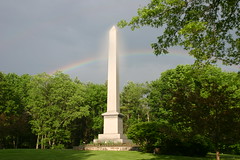This log cabin is one of only two existing pioneer homes built in 1847; the other is Levi E. Riter’s log house located in This Is the Place Heritage Park. It gives us a good idea of the typical small homes built by the pioneers when they first arrived in the Salt Lake Valley.
David M. Whitchurch

_____________________________________________________________
Hallowed Ground Sacred Journeys
_____________________________________________________________
The Deuel families, formerly well-to-do residents of Nauvoo, were among the first pioneers to enter the Salt Lake Valley. Upon arrival, Osmyn Deuel began to construct a small log cabin, which was completed in September 1847. It was originally part of the Old Fort—the first permanent settlement built by the pioneers— which stood at 300 West and 400 South.

Kitchenware and other tools inside the Deuel Log Cabin.
Robert L. Hall
The cabin is now in its fifth location since it was first constructed. Originally, the home served as the residence for two brothers, Osmyn M. and William H. Deuel, and their families. The cabin served as the headquarters for Captain Howard Stansbury during his 1849–50 survey of the Great Salt Lake, and later as the home of LDS Apostle Albert Carrington’s daughter Frances and her husband, Zebulon Jacobs. In 1910 the Deseret Museum curator received the cabin from the Jacobs and moved it to the history gallery at the museum. It later sat on the southeast corner of Temple Square before being moved to its current location.

Hand tinted photo of Deuel Cabin.
C. R. Savage courtesy of Richard K. Winters
A portrait of William Henry Deuel and his wife Eliza Avery Whiting.
Daughters of Utah Pioneers
President Ezra Taft Benson told a story about the Deuel cabin
"Years ago we had in the Quorum of the Twelve a great teacher by the name of Adam S. Bennion. On occasion when youth groups would come to Church headquarters, he would escort them over to Temple Square. He always took them to the southeast corner where the Osmyn Deuel log cabin stood. He would tell the young people that this was the kind of home many of their pioneer forefathers lived in—a one-room log hut with no bathroom, no indoor plumbing, no privacy.
He would then request the group to stand midway between the temple and the old log cabin. Then he taught: “On your right you see the circumstances of those early pioneers—how they lived—but on your left you see the temple—the vision they had of the future.”
That is what we hope happens when individuals visit this museum—they will see what their forebears wrought and that this will give a perspective to the present that will inspire them to build a more glorious, a more righteous, future. Our past, after all, is our prologue to the future."
_________________________
The marker in front of the cabin reads:
Residence of Osmyn and Mary Deuel and Osmyn’s brother, Amos, from fall 1847 to spring 1848.
This historic structure is one of two surviving homes built by the Mormon pioneers upon arrival in Salt Lake Valley in 1847 (the other is located at This is the Place State Park at the mouth of Emigration Canyon to the northeast). Originally it was part of the north extension of the pioneer fort erected by members of the Church of Jesus Christ of Latter-day Saints one mile southwest of here.
The home, 15 feet by 20 feet, was constructed of Douglas Fir and lodge pole pine brought from the mountains east of the city. As restored by the Museum of Church History and Art, its furnishings reflect the lifestyle of the Deuels. Osmyn and Mary were among the most prosperous of the 1847 pioneers.
Osmyn was a blacksmith but he also farmed. Another log structure owned by the Deuels in the fort’s north enclosure probably served as the blacksmith shop. There Osmyn and his brother, William H., whose family lived next to Osmyn and Mary, carried on their trade. It is supposed that Amos worked in the shop also. The Deuels tilled and planted fourteen acres their fi rst season in the valley and also had a garden plot near their homes.
The Deuels were natives of New York. A number of this extended family were Latter-day Saint converts in the early 1830s. They lived in Kirtland, Ohio, and Nauvoo, Illinois, before emigrating west.
After the Deuels left the log home to settle in Centerville, Utah, it is reported that the cabin was used briefly as a militia armory. In 1849 Albert Carrington, later an apostle in the Church, purchased the home and moved it to his property one and one half blocks north of here. It was acquired by the Deseret Museum in 1912. From 1919 to 1976 it was exhibited on Temple Square, then stored until it was moved to its present site where, amidst a landscape of pioneer and native plants, it was opened 19 November 1985.
___________________________________________________________________
___________________________________________________________________
Brigham Young University Religious Education presents
Hallowed Ground Sacred Journeys
Featuring BYU Religious Educators teaching about sites significant in
The Church of Jesus Christ of Latter-day Saints
For more information, or to visit our interactive web site with dozens of additional sites to explore,
please visit VirtualTours.BYU.edu
Hallowed Ground Sacred Journeys
is a co-production of
This blog is a public service of The Watchmen Institute
and is distributed by B.U.M.P. LTD.
All Rights Reserved




1 comments:
The portrait of William Henry Deuel and his wife Eliza Avery Whiting is a great find for me! They were my great-great-grandparents. I have also documented that William's ancestry has a common link to Pete Duel (a.k.a. Peter Ellstrom Deuel) from the 1970's TV series, "Alias Smith and Jones".
Post a Comment